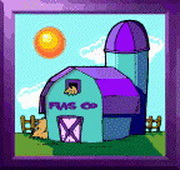Breeds of Goats
The breeds of goats can be broken down into three categories:
- Dairy goats
- Meat goats
- "Other" (fiber, duel-purpose, etc).
This listing is of the most common types of goats found in the US.
DAIRY GOATS
Alpine |
|
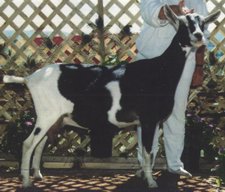 |
The Alpine, also known as "French Alpine", originated in the Alps. They are medium to large goats with upright ears. Alpines are hardy, adaptable and come in a variety of colors and patterns. Their milk has an average butterfat of about 3.5%. Alpines are seasonal breeders. |
LaMancha |
|
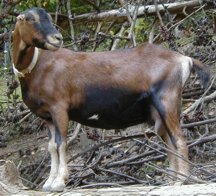 |
The LaMancha is a medium sized breed, developed in the USA from goats of Spanish origin. They have an excellent dairy temperament and are all-around sturdy, friendly, naturally healthy animals. LaManchas can come in a variety of colors and patterns. Their milk has an average butterfat of about 4.2%. LaManchas have tiny ears which come in two types: "gopher ears", which are little "sweet rolls"; and "elf ears", which are little hooked ears less than 2 inches long. LaManchas are seasonal breeders. |
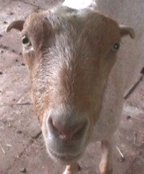 |
Elf Ears |
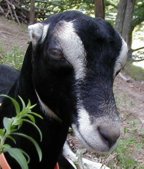 |
Gopher Ears |
Nigerian Dwarf |
|
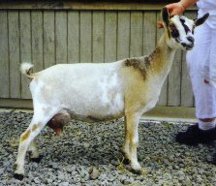 |
The Nigerian is a miniature dairy goat of West African origin with upright ears. They are bred to have the length of body and structure, in proportion, of a full sized dairy goat. They come in a variety of colors and patterns. Nigerians can also produce a surprising amount of milk for their size (3-4 four pounds per day) but their small teats can sometimes be difficult to milk. Their milk has an average butterfat of about 6.1%. Nigerians breed year round. |
Nubian |
|
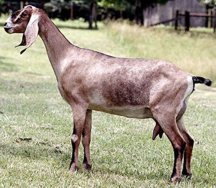 |
The Nubian, also know as "Anglo-Nubians" is a large, proud, and graceful goat with long pendulous ears and a "Roman nose". They were developed in England by crossing British goats with bucks of African and Indian origin. They are not heavy producers but milk has an average butterfat of about 4.6%. Nubians come in a variety of colors and patterns. They are very vocal. They are very popular but not quite as hardy as some other breeds Nubians are usually seasonal breeders but sometimes may breed year round. |
Oberhasli |
|
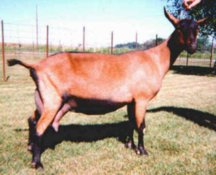 |
The Oberhasli, sometimes called "Swiss Alpine", are a medium sized breed. Their coloring is known as "Chamoisee" which is bay in color with distinctive and specific black markings. Does may sometimes be black but chamoisee is preferred. Their milk has an average butterfat of about 3.6%. Oberhaslis are seasonal breeders. |
Saanen |
|
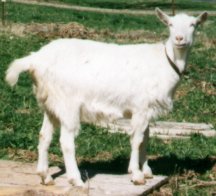 |
The Saanen goat originated in Switzerland. They are white, large in size with upright ears. Saanens are heavy milk producers, but there milk is lower in butterfat than some of the other dairy breeds. Their milk has an average butterfat of about 3.5%. Note: Saanens must be white. If a Saanen is born with color (which sometimes happens) they are called "Sables". Saanens are seasonal breeders. |
Toggenburg |
|
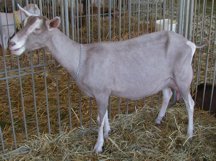 |
The Toggenburg is a Swiss breed credited as being the oldest known dairy goat breed. They are medium in size with upright ears. "Togg" coloring is varying from a light fawn to dark chocolate, with distinctive and specific white markings. Their milk has an average butterfat of about 3.3%. This breed was originally developed to provide milk for cheese production and so their milk can sometimes have a strong flavor. Toggs are seasonal breeders. |
MEAT GOATS
Boer |
|
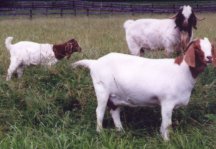 |
The Boer goat was developed in South Africa. They have long pendulous ears and a "Roman" nose. "Boer" is a Dutch word meaning farmer. The major portion of the Boer's body is white with dark coloration around the head. Their horns curve backwards. They are gentle, strong and vigorous. Boers breed year round. |
Kiko |
|
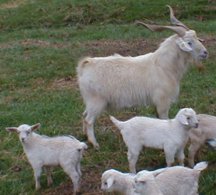 |
Kiko goats were bred up on a base of feral goat stock in New Zealand. They were selected for survivability under range conditions. The Maori word “kiko” means simply flesh or meat. Kikos breed year round. |
Spanish Meat Goat |
|
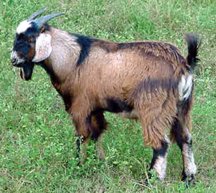 |
Spanish meat goats, also sometimes called "Brush goats", are the descendants of goats first brought to North America by European explorers. They are a medium sized goat; short, stocky and heavily muscled. Spanish Meat goats are very hardy and can come in a variety of colors. Spanish Meat goats breed year round. |
Tennessee Fainting Goat |
|
 Crimped ear |
Tennessee Fainting Goats are also know by many other names: Myotonic, "Stiff-legged", "Nervous", Tennessee Meat, Wooden Leg, and Scare goats. They are a small to medium sized goat (not a miniature). These goats possess a genetic characteristic, called myotonia congenita, which causes their muscles to lock up when they are startled or surprised resulting in them falling over. Their coats can be long or short, but never curly like Angoras. They come in a variety of colors including black, tan, red, brown, and white. Fainting goats can have a at least three types of ears to be correct. There should always be a crease in the middle of the ear. One type of ear would be the long, "airplane" ears. These don't point straight out to the sides, but angle more toward the eyes. Another type is a shorter ear. A third type of ear can have a crimp across the end of the ear. Fainting goats breed year round. |
 |
Short ear |
 |
Airplane ear / long coat |
"OTHER" GOAT TYPES
Angora |
|
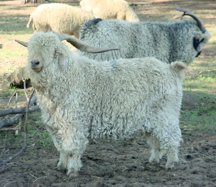 |
Angora goats are a medium sized breed that grow very long curly coats, known as mohair. They are of Turkish origin. Angoras are fairly laid back and docile but not very hardy. Angoras are seasonal breeders. |
Pygora |
|
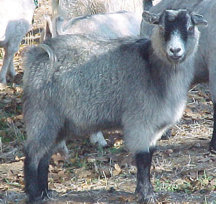 |
A Pygora goat is a breed purposely bred and then registered in Oregon by Katherine Jorgensen. She wanted an animal, which would produce fine fiber for hand spinning. She bred the Pygmy, a goat with short, soft down to the Angora, a goat with long silky fleece. There are three different fleece types. No one type is "better" than the other is; they just have different characteristics. Type "A":
(Angora type)---A long, lustrous fiber up to 6 inches long, Type "B":
(Blend type)---A blend of the Pygmy goat undercoat which is cashmere
and the Angora mohair. It is between 3 and 6 inches long, and
it has a nice crimp (curl). The second coat is usually obscured
by the type "B" fleeces that is 3 to 6 inches long.
Type "B" can either be lustrous (shiny), or have a matte
(dull) finish. This fleece type is the most common, and Type "C ": (Cashmere type)---A very fine fiber, with no luster, and length of 1 to 3 inches. The hair coat looks very coarse in comparison to the two types above. Type "C" can be acceptable commercial cashmere. These goats may be shorn or combed. Most Pygoras produce from 6 ounces to 2 pounds per shearing. Many Type "A"s are sheared twice per year. |
Kinder |
|
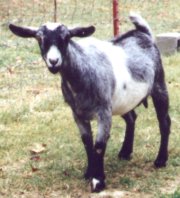 |
Kinders are a small duel propose breed (both for dairy and meat) developed in the US by crossing Nubians with Pygmies. They come in a variety of colors and patterns. Kinders breed year round. |
Pygmy |
|
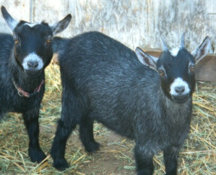 |
Pygmy goats are small goats of African origin. They are considered meat goats but are mainly used as pets. Pygmies are bred to be "cobby" and heavy boned. All body colors are acceptable but breed-specific markings are required. Pygmies breed year round. |
Scrub Goat |
This terms refers to "mutt" goats of mixed and/or unknown breeding. |
